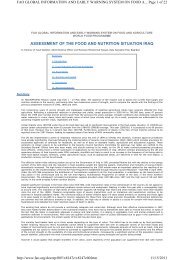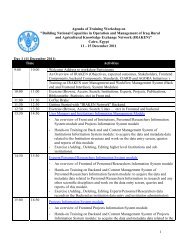Vermiculture in Egypt: - FAO - Regional Office for the Near East and
Vermiculture in Egypt: - FAO - Regional Office for the Near East and
Vermiculture in Egypt: - FAO - Regional Office for the Near East and
You also want an ePaper? Increase the reach of your titles
YUMPU automatically turns print PDFs into web optimized ePapers that Google loves.
The United Nations Framework Convention on Climate Change – UNFCCC was<br />
agreed at <strong>the</strong> United Nations Conference on Environment <strong>and</strong> Development<br />
(UNCED) <strong>in</strong> Rio de Janeiro, 1992. This agreement aims at <strong>the</strong> stabilization of<br />
greenhouse gases <strong>in</strong> <strong>the</strong> atmosphere, at a level that would prevent dangerous changes<br />
to <strong>the</strong> climate.<br />
The UNFCCC adopted Kyoto Protocol at <strong>the</strong> third conference of parties (COP3) <strong>in</strong><br />
Kyoto, Japan <strong>in</strong> 1997. The Protocol sets b<strong>in</strong>d<strong>in</strong>g commitments by 39 developed<br />
countries <strong>and</strong> economies <strong>in</strong> transition, listed <strong>in</strong> Annex B, to reduce <strong>the</strong>ir greenhouse<br />
gas emissions by an average of 5.2 per cent on 1990 levels (<strong>the</strong> first commitment<br />
period, 2008 - 2012).<br />
The UNFCCC divides countries <strong>in</strong> two ma<strong>in</strong> groups: Annex I parties that <strong>in</strong>clude <strong>the</strong><br />
<strong>in</strong>dustrialized countries <strong>and</strong> countries with “economies <strong>in</strong> transition” /EITs (<strong>the</strong><br />
Russian Federation, <strong>the</strong> Baltic States <strong>and</strong> several o<strong>the</strong>r Central <strong>and</strong> <strong>East</strong>ern European<br />
countries). All <strong>the</strong> o<strong>the</strong>rs are called non-Annex I countries.<br />
Annex I countries that have ratified <strong>the</strong> Kyoto Protocol can <strong>in</strong>vest <strong>in</strong> projects that both<br />
reduce greenhouse gases <strong>and</strong> contribute to susta<strong>in</strong>able development <strong>in</strong> non-Annex I<br />
countries. A CDM project provides certified emissions reductions (CERs) to Annex I<br />
countries, which <strong>the</strong>y can use to meet <strong>the</strong>ir greenhouse gas reduction commitments<br />
under <strong>the</strong> Kyoto Protocol. Article 12 of <strong>the</strong> Kyoto Protocol sets out three goals <strong>for</strong> <strong>the</strong><br />
CDM: i) To help mitigate climate change; ii) To assist Annex I countries atta<strong>in</strong> <strong>the</strong>ir<br />
emission reduction commitments, <strong>and</strong> iii) To assist develop<strong>in</strong>g countries <strong>in</strong> achiev<strong>in</strong>g<br />
susta<strong>in</strong>able development.<br />
In addition to contribute towards susta<strong>in</strong>able development, CDM project c<strong>and</strong>idates<br />
look<strong>in</strong>g <strong>for</strong> approval under <strong>the</strong> CDM must lead to real, measurable reductions <strong>in</strong><br />
greenhouse gas emissions, or lead to <strong>the</strong> measurable absorption (or “sequestration”) of<br />
greenhouse gases <strong>in</strong> a develop<strong>in</strong>g country. The six greenhouse gases <strong>and</strong> gas classes<br />
com<strong>in</strong>g from varied sources of <strong>the</strong> economy are: carbon dioxide "CO2" (source: fossil<br />
fuel combustion; de<strong>for</strong>estation; agriculture); methane "CH4" (source: agriculture; l<strong>and</strong><br />
use change; biomass burn<strong>in</strong>g; l<strong>and</strong>fills); nitrous oxide "N2O" (source: fossil fuel<br />
combustion; <strong>in</strong>dustrial; agriculture); hydrofluorocarbons "HFCs" (source: <strong>in</strong>dustrial<br />
/manufactur<strong>in</strong>g); perfluorocarbons "PFCs" (source: <strong>in</strong>dustrial/manufactur<strong>in</strong>g); sulphur<br />
hexafluoride "SF6" (source: electricity transmission; manufactur<strong>in</strong>g(.<br />
The basel<strong>in</strong>e <strong>for</strong> a CDM project is <strong>the</strong> scenario used to show <strong>the</strong> trend of<br />
anthropogenic greenhouse gas emissions that would occur <strong>in</strong> <strong>the</strong> absence of <strong>the</strong><br />
proposed CDM project. The basel<strong>in</strong>e basically shows what would be <strong>the</strong> future<br />
greenhouse gas emissions without <strong>the</strong> CDM project <strong>in</strong>tervention. Each CDM project<br />
has to develop its own basel<strong>in</strong>e. Once a basel<strong>in</strong>e methodology has been approved by<br />
<strong>the</strong> Executive Board, o<strong>the</strong>r projects can use it too. For small-scale projects, guidance<br />
is provided on st<strong>and</strong>ard basel<strong>in</strong>es.<br />
Greenhouse gas emissions from a CDM project activity must be reduced below those<br />
that would have occurred <strong>in</strong> <strong>the</strong> absence of <strong>the</strong> project. It must be shown that <strong>the</strong><br />
project would not have been implemented without <strong>the</strong> CDM. Without this<br />
“additionality” requirement, <strong>the</strong>re is no guarantee that CDM projects will create<br />
72





